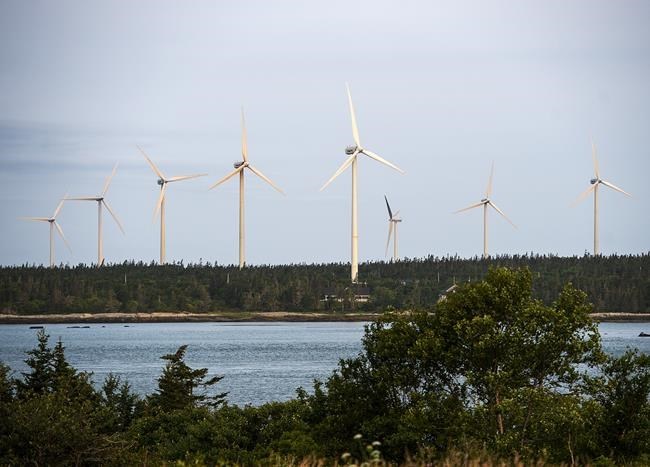
Industry Minister François-Philippe Champagne is warning that the country is reaching the limits of its abundant renewable energy capacity and making more electricity is going to be key to keeping the wins coming. The West Pubnico Point Wind Farm is seen in Lower West Pubnico, N.S. on Monday, Aug. 9, 2021. THE CANADIAN PRESS/Andrew Vaughan
Republished January 03, 2024 - 1:42 PM
Original Publication Date January 03, 2024 - 9:56 AM
OTTAWA - Industry Minister François-Philippe Champagne spent most of last year doling out big bucks for massive new electric-vehicle battery plants as Canada made some major moves to solidify its green industrial strategy.
But he is warning that the country is reaching the limits of its abundant renewable energy capacity, and making more electricity is going to be key to keeping the wins coming.
"I think energy generation could be a limiting factor," said Champagne in an interview with The Canadian Press in December.
He said 2023 was the year "where our green industrial policy is taking shape."
Over the course of the year, Canada announced several major new plants, including the Volkswagen EV battery plant in St. Thomas, Ont., and a major new Dow Chemical plastics factory in Alberta.
Swedish battery maker Northvolt is building its first North American battery factory near Montreal.
A major battery plant is also being built in Windsor, Ont., by Stellantis and LG Energy Solution. They renegotiated their deal with the federal government last year so it would be as generous as the Volkswagen deal, which includes billions in potential subsidies for every battery they make.
Champagne said for 2024, the focus is going to be on ramping up support for the small- and medium-sized businesses that will support those mega projects, along with the power needed to run them all.
"We're talking about: how do you develop more mining, more refining?" the minister said. "What you need is to bring power to these communities."
He said Canada needs to focus heavily in the coming months and years on developing small nuclear reactors and expanding other renewable energy sources, noting power has already become a factor in project approvals.
"We have seen a number of projects where we have to see where they can go in the country, because some jurisdictions are getting strained with respect to the capacity of energy generation," he said.
Champagne did not identify the projects. But his warning echoes that of Quebec's Energy Minister Pierre Fitzgibbon, who said last year that his province had some tough choices ahead.
In a speech at the Chamber of Commerce of Metropolitan Montreal in May, Fitzgibbon said demand for power was surging so fast that Quebec — which produces more than one-third of Canada's total electricity supply — was going to max out its electricity surpluses by the end of 2026.
"Our surpluses have melted like glaciers under the sun of climate change," Fitzgibbon said.
He said demand is growing so quickly that the province isn't going to be able to say yes every time an industrial user seeks more power to expand or set up shop in Quebec.
"For the next 10 years, it will be tight and choices will have to be made," Fitzgibbon said.
Canada is already among the best in the world at producing electricity from non-emitting sources. Nationally, more than 80 per cent of electricity comes from hydro dams, wind farms, solar panels and small amounts of tidal power and biomass.
But the federal government expects that to power its climate transition, the country will need two to three times as much renewable energy by 2050.
By 2035, Canada intends to have 100 per cent of electricity be non-emitting, meaning it uses renewable fuels or fossil-fuel facilities equipped with carbon capture and storage systems.
The federal government is also insisting that gas-powered cars stop being sold after 2035, and for most medium- and heavy-duty vehicles to be run on electricity by 2040.
And Ottawa is pushing electric heat pumps as a better option for home heating than traditional gas or oil furnaces, at the same time as it pushes big industry to use less fossil fuels.
All of that is going to take substantially more power.
The Canada Energy Regulator predicts demand for electricity will grow by nearly 50 per cent in the next 30 years, heavily driven by the needs of electric vehicles and hydrogen production.
Evan Pivnick, program manager at Clean Energy Canada at Simon Fraser University, said Canada's electrical supply has grown very incrementally over time, and is suddenly faced with a massive expansion in just a couple of decades.
"The reality is we haven't been through this kind of transition before," he said.
Pivnick said that to date, the system has often grown on demand. But Canada now needs to start building more power to offer investors when they're looking for a place to set up a new shop.
That is going to take some co-ordination by governments, utilities and industries that hasn't always happened before, he said.
Volkswagen is among the companies that made clear it chose Canada for its first North American EV battery plant last year in part because of the access to renewable power.
Champagne is clear that clean power is a major selling point for him in any conversation with investors.
This report by The Canadian Press was first published Jan. 3, 2024.
News from © The Canadian Press, 2024